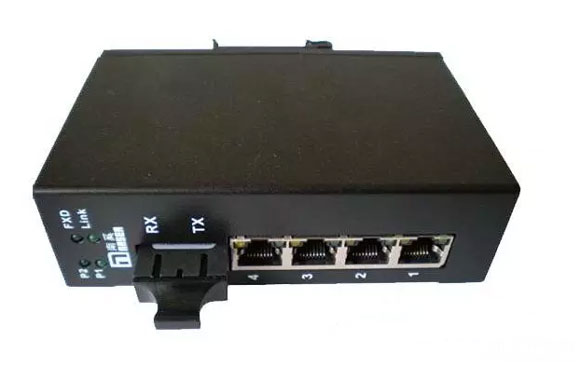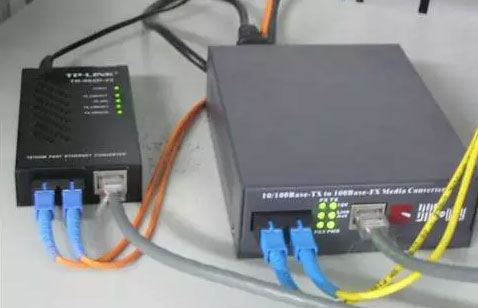Optical fiber transceivers,also known as optical-to-electrical converters,are Ethernet transmission media conversion units that exchange short-range twisted pair electrical signals with long-range optical signals.Different observation angles make people have different understandings of optical fiber transceivers.For example,they are divided into single 10M and 100M optical fiber transceivers,10/100M adaptive optical fiber transceivers,and 1000M optical fiber transceivers according to the transmission rate;Fiber optic transceivers working at the physical layer and fiber optic transceivers operating at the data link layer;from a structural point of view,desktop(stand-alone)fiber optic transceivers and rack-mounted fiber optic transceivers;depending on the access fiber There are two types of multimode fiber transceivers and single mode fiber transceivers.
Fiber Transceiver
Optical fiber transceivers,also known as optical-to-electrical converters,are Ethernet transmission media conversion units that exchange short-range twisted pair electrical signals with long-range optical signals.Different viewing angles make people have different understandings of optical fiber transceivers.For example,they are divided into single 10M and 100M optical fiber transceivers,10/100M adaptive optical fiber transceivers,and 1000M optical fiber transceivers according to the transmission rate;Fiber optic transceivers working at the physical layer and fiber optic transceivers operating at the data link layer;from a structural point of view,desktop(stand-alone)fiber optic transceivers and rack-mounted fiber optic transceivers;depending on the access fiber There are two types of multimode fiber transceivers and single mode fiber transceivers.There are also single fiber transceivers and dual fiber transceivers,built-in power fiber transceivers and external power fiber transceivers as well as network managed fiber transceivers and unmanaged fiber transceivers.Fiber optic transceivers break the 100-meter limitation of Ethernet cables in data transmission,and rely on high-performance switching chips and large-capacity caches to provide real-time non-blocking transmission switching performance while also providing balanced traffic and isolation conflicts.Detect errors and other functions to ensure high security and stability in data transmission.
In essence,the fiber transceiver simply completes the data conversion between different media and can realize the connection between two switches or computers within 0-100Km,but the actual application has more extensions.
1,to achieve the interconnection between switches.
2,to achieve the interconnection between switches and computers.
3,to achieve the interconnection between computers.
4,transmission relay:When the actual transmission distance exceeds the transceiver's nominal transmission distance,especially the actual transmission distance exceeds 100Km,when the site conditions allow,using two transceivers back to back relay,is a A very cost-effective solution.
5,single multi-mode conversion:When the network needs to be a single multi-mode fiber connection,you can use a multi-mode transceiver and a single-mode transceiver to connect back to back,to solve the problem of single multi-mode fiber conversion.
6,wavelength division multiplex transmission:When long-distance optical cable resources are insufficient,in order to improve the use of optical fiber cable,reduce the cost,the transceiver and wavelength division multiplexer can be used in conjunction,so that two-way information transmitted on the same pair of optical fiber.
Fiber Transceiver Usage Considerations
From the introduction,we know that there are many different classifications of optical transceivers,and most of the attention in practical use is based on the category of optical fiber connectors:SC connector optical transceivers and ST connector optical transceivers.
When using fiber optic transceivers to connect different devices,care must be taken to use different ports.
1.Connection of fiber transceivers to 100BASE-TX devices(switches,hubs):
Make sure the length of twisted pair does not exceed 100 meters.
Connect one end of the twisted pair to the RJ-45 port(Uplink port)of the fiber transceiver and the other end to the RJ-45 port(common port)of the 100BASE-TX setup(switch,hub).
2.Connection of fiber transceivers to 100BASE-TX devices(network cards):
Make sure the length of twisted pair does not exceed 100 meters.
Connect one end of the twisted pair cable to the RJ-45 port(100BASE-TX port)of the fiber transceiver and the other end to the RJ-45 port of the network card.
3,fiber optic transceiver to 100BASE-FX connection:
Make sure that the length of the fiber does not exceed the distance that the device can provide;
One end of the fiber is connected to the SC/ST connector of the fiber transceiver and the other end is connected to the SC/ST connector of the 100BASE-FX device.
It is also necessary to add that many users consider using fiber optic transceivers as long as the length of the fiber can be used within the maximum distance supported by single mode fiber or multimode fiber.In fact,this is a wrong understanding.This understanding is only correct when the connected devices are full-duplex devices.When there are half-duplex devices,the transmission distance of the optical fiber is limited.
Purchase principle
The main task of the fiber transceiver as a regional network connector device is how to seamlessly connect the two data.Therefore,we must consider the compatibility of its compatibility with the surrounding environment,as well as the stability and reliability of its own products.On the contrary,if the price is lower,it cannot be used!
1.Does it support full-duplex and half-duplex?
Some chips currently available in the market can only use a full-duplex environment and cannot support half-duplex operations.For example,if you receive a switch(SWITCH)or a hub(HUB)from another brand,and it uses half-duplex mode,it will definitely cause Serious conflicts and lost packets.
2.Has it been tested with other fiber transceivers?
Currently,there are more transceivers for optical transceivers on the market.For example,if the compatibility of different brands of transceivers has not been tested beforehand,packet loss,long transmission time,and erratic behavior will occur.
3.Is there a safety device against packet loss?
Some manufacturers in the manufacture of fiber transceiver transceivers,in order to reduce costs,the use of Register(Register)data transmission mode,the biggest drawback of this approach is the transmission instability,packet loss,and the best is to use buffer circuit design,Data loss can be safely avoided.
Use of fiber optic transceivers
4,temperature adaptability?
When the fiber transceiver itself is used,it will generate high heat,when the temperature is too high(usually can not be large with 85°C),the fiber optic transceiver is working properly?What is the maximum allowable operating temperature?For a device that needs long-term operation is very It is worth our attention!
5.Does it comply with the IEEE802.3u standard?
If the fiber optic transceiver conforms to the IEEE802.3 standard,that is,the delay time is controlled at 46 bits.If it exceeds 46 bits,it means that the distance transmitted by the optical fiber transceiver will be shortened!
6,after-sales service In order to make timely and timely response to after-sales service,it is recommended that customers choose a strong professional company with strong technical strength and good reputation.Only the professional company's technical engineers have more experience in troubleshooting,and the tools for detecting faults are more advanced!





